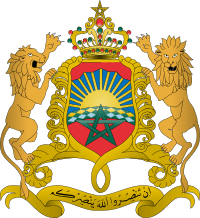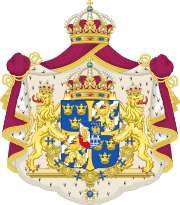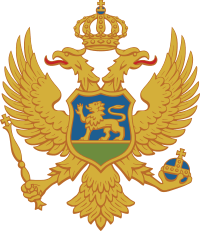Lion (heraldry)
The lion is a common charge in heraldry. It traditionally symbolises bravery, valour, strength, and royalty, because historically it has been regarded as the king of beasts.
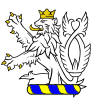 Lion as a crest |
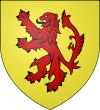 Lion as a primary charge |
|---|
Attitudes
As many attitudes (positions) now exist in heraldry as the heraldist's imagination can conjure, as a result of the ever-increasing need for differentiation, but very few of these were apparently known to medieval heralds.[1] One distinction commonly made (especially among French heralds), although it may be of limited importance, is the distinction of lions in the walking positions as leopards.[1] The following table summarizes the principal attitudes of heraldic lions:
| Attitude | Example | Description |
|---|---|---|
| Rampant | 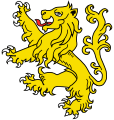 |
A "lion rampant" is depicted in profile standing erect with forepaws raised.[2] The position of the hind legs varies according to local custom: the lion may stand on both hind legs, braced wide apart, or on only one, with the other also raised to strike; the word rampant is often omitted, especially in early blazon, as this is the most usual position of a carnivorous quadruped;
Note: the term segreant denotes the same position, but is only used in reference to winged four-legged beasts like griffins and dragons.[3] |
| Passant |  |
A "lion passant" is walking, with the right fore paw raised and all others on the ground.[4] A "Lion of England" denotes a lion passant guardant Or, used as an augmentation.[4]
Note: A lion thus depicted may be called a "leopard" (see discussion below). |
| Statant |  |
A "lion statant" is standing, all four feet on the ground, usually with the forepaws together.[5] This posture is more frequent in crests than in charges on shields.[6] |
| Salient | 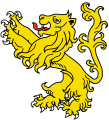 |
A "lion salient" is leaping, with both hind legs together on the ground and both forelegs together in the air.[6] This is a very rare position for a lion,[6] but is also used of other heraldic beasts. |
| Sejant |  |
A "lion sejant" is sitting on his haunches, with both forepaws on the ground.[7] |
| Sejant erect |  |
A "lion sejant erect" is seated on its haunches, but with its body erect and both forepaws raised in the "rampant" position (this is sometimes termed "sejant-rampant").[7] |
| Couchant |  |
A "lion couchant" is lying down, but with the head raised.[8] |
| Dormant |  |
A "lion dormant" is lying down with its eyes closed and head lowered, resting upon the forepaws, as if asleep.[8] |
Other terms are used to describe the lion's position in further detail. It should be noted that each coat of arms has a right and left (i.e. dexter and sinister) side - with respect to the person carrying the shield - so the left side of the shield as drawn on the page (thus the right side to the shield bearer) is called the dexter side. The lion's head is normally seen in agreement with the overall position, facing dexter (left) unless otherwise stated. If a lion's whole body is turned to face right, he is to sinister or contourné. If his whole body faces the viewer, he is affronté. If his head only faces the viewer he is guardant or gardant, and if he looks back over his shoulder he is regardant. These adjectives follow any other adjectives of position.
A lion (or other beast) coward carries the tail between its hind legs.[9] The tail also may be knotted (nowed), forked (queue fourchée) or doubled (double-queued); as in the arms of the kingdom of Bohemia.
-
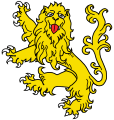
Lion guardant
-
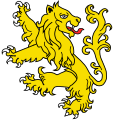
Lion regardant
-
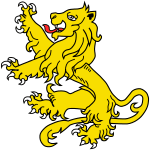
Lion coward
-

Lion with forked tail
-
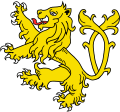
Lion with crossed tail
-
.svg.png)
Lion with crossed tail (reverse)
-
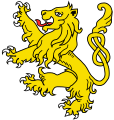
Lion with tail nowed
Lions vs. Leopards

Both lions and leopards may have been among the earliest beasts to appear in heraldry. The Oxford Guide to Heraldry notes that the earliest English treatise on heraldry, a late-13th or early-14th century Anglo-Norman manuscript titled De Heraudrie,[10] mentions the griffin, lion, leopard, eagle, martlet, popinjay, crow, swan and heron.[11] Citing Bado Aureo, the Oxford Guide further suggests that the leopard, said to be "borne of an adulterous union between a lioness and a pard," and like a mule incapable of reproducing, may be an appropriate charge for a person born of adultery or barred from reproducing (such as an abbot).[12]
As a general rule, English heralds tend to identify lions as rampant (upright, in profile facing dexter), and leopards as passant guardant (walking, head turned to full face), but the heraldic distinction between lions and leopards is often ambiguous and in some cases may be controversial (as in the case of the royal arms of England, discussed below). Part of the confusion arises from international differences in translation or in the defining characteristics of each, particularly in charges that show some characteristics of each.
English herald Arthur Charles Fox-Davies asserted in 1909 that the term leopard, denoting a lion passant guardant, was a term of French origin that had "long since become obsolete in English armory. In French blazon, however, the old distinction is still observed." Fox-Davies continued, "[French heralds] term our lion passant a léopard-lionné, and our lion rampant guardant is their lion-léopardé."[13] Dutch heraldist Johannes Rietstap, however, defined a Léopard lionné as a lion rampant guardant (i.e., upright like a lion with its head turned to full face like a leopard) and a Lion léopardé as a lion passant (i.e., walking like a leopard with its head facing dexter like a lion).[14] German-American heraldist Carl-Alexander von Volborth agrees with Rietstap's translations, in contrast to those of Fox-Davies as stated above.[15]
As if to clarify the situation, English heraldist Hugh Clark wrote in his Introduction to Heraldry (1829):
- The true heraldic lion, according to French authors, is always to be represented in profile, or, as the ancient heralds say, showing but one eye and one ear. His attitude, also, should always be rampant or ravaging. When passant and full-faced, they blazoned him a leopard, vide Lion Leopardé: in England, however, the lions in the royal and other achievements have always been blazoned as lions, however depicted since the time of Henry III, in whose reign they were called "Leopards".
- Lion Leopardé...is a French term for what the English call a Lion passant gardant. The word leopard is always made use of by the French heralds to express in their language, a lion full-faced, or gardant. Thus, when a lion is placed on an escutcheon in that attitude which we call rampant gardant, the French blazon it a Lion Leopardé. When he is passant only, they call him leopard lioné.[16]
English heraldist Charles Boutell wrote in 1890 that the lions of England were generally termed leopards until the end of the 14th century, including in the roll of arms of Henry III of England, and in a statute of Edward I of England, dating to 1300, which made reference to "signée de une teste de leopart—marked with the King's lion."[17] In English Heraldry (1867), Boutell explained:
- Only when he was in this rampant attitude did the early Heralds consider any Lion to be a Lion, and blazon him by his true name. A lion walking and looking about him, the early Heralds held to be acting the part of a leopard: consequently, when he was in any such attitude, they blazoned him as "a leopard." The animal bearing that name bore it simply as an heraldic title, which distinguished a Lion in a particular attitude. These heraldic "leopards" were drawn in every respect as other heraldic "lions," without spots or any leopardish distinction whatever. This explains the usage, retained until late in the 14th century, which assigned to the Lions of the Royal Shield of England the name of "leopards." They were so called, not by the enemies of England for derision and insult, as some persons, in their ignorance of early Heraldry, have been pleased both to imagine and to assert; but the English Kings and Princes, who well knew their "Lions" to be Lions, in blazon styled them "leopards," because they also knew that Lions in the attitude of their "Lions" were heraldic "leopards."[18]
In Heraldry: Sources, Symbols and Meaning (1976), German heraldist Ottfried Neubecker explained:
- When the blazon does not specifically mention a position, the lion may be assumed to be rampant. If he is in a different position, other terminology must be used, referring to the position of his head and limbs. An early heraldic convention found in medieval blazons uses the distinction between a lion and a leopard previously employed by the ancient Greeks. In antiquity, the lion, having a heavy mane, was generally shown in profile, while the leopard, having less hair, was shown looking towards the observer. A lion looking towards the observer therefore came to be given the name of the animal usually shown in that pose.[19]
According to Neubecker, what in Old French is termed a léopard is always guardant (head turned toward the observer), thus the modern English heraldic terms "lion passant guardant", "lion passant", and "lion rampant guardant" correlate to the Old French terms léopard, lion léopardé, and léopard lionné respectively.[20]
Long history of lion imagery

Lions have been represented figuratively since the Stone Age. Ice age hunters depicted the lion this way in the cultural stage of the Aurignacian more than 30,000 years ago by showing the lionesses of a pride hunting in the same manner as contemporary lions. After that it frequently was the lioness who was represented as the protector and chief warrior of a culture. An early Naqada tomb painting that predates Egyptian culture in northern Africa shows two rampant lions flanking a figure that may be interpreted as a deity.
Lions also play a role in numerous later ancient cultures. In Ancient Egypt the pharaoh sometimes was represented as the sphinx, a lioness with a human head. The best known representation of this type is the Great Sphinx of Giza. From the earliest written human records, the lioness was recognized as the fierce hunter of the formidable species in Ancient Egyptian and African cultures and was dominant in the pantheons of these ancient cultures as representing warriors and protectors of the country. Egyptian mythology featured images of lionesses such as Bast and Sekhmet from their pantheon. Male rulers might be associated with the son of the goddess, such as Maahes. While the Egyptians ruled over Nubia they documented the worship of Dedun as a god of wealth and prosperity, who was said to be the son of the Nubian lioness deity, although they did not incorporate that deity into their own pantheon. The ancient Egyptians also created naturalistic portrayals of lions as symbols of protection and royal power in addition to the images of mythical sphinxes.
In the near east a long line of cultures used the motif of Lions as both a symbol of primal and royal power. The earliest examples come from Mesopotamia. This usage continued throughout the later cultures of the Hittites, Babylonians, Assyrians, Persians and early Islamic cultures like the Umayyads and Abbassids.
-

Cave lions, Chamber of Felines, Lascaux caves
-

Ancient Egyptian reclining lion statue created during reign of Amenhotep III
In ancient Indian civilisations, lions were adopted as symbols of many dynasties, the famous one being the Lion Capital of Ashoka. This is a sculpture of four "Indian lions" standing back to back. This was used during the reign of Emperor Ashoka of the Maurya Dynasty who ruled a large part of the Indian subcontinent from c. 269 BC to 232 BC. A variant of this was later adopted as the National Emblem of India.

In antiquity, lions were common along the southern coast of the Mediterranean, as well as in Greece and the Middle East. In Greek mythology a lion appears in a variety of functions. The Lion Gate of Mycenae features two rampant lionesses who flank a central column representing the major deity of this early Greek culture that dates to the second millennium BC. In later classical Greek mythology, the Nemean Lion was portrayed as a people-eating beast; killing it was one of the twelve tasks assigned to Heracles. In the story of Androcles, one of Aesop's fables, the hero, a runaway slave, pulls a thorn from a lion's paw; when he is later thrown to the lions as punishment for escaping, the lion recognizes him once again and refuses to kill the man. According to the Book of Genesis of the Hebrew Bible, the Israelite Tribe of Judah had the Lion of Judah as its symbol.
The characteristic of the lion as the "king of the jungle" goes back to the influence of the Physiologus, an early Christian book about animal symbolism which spread into many cultures and generally had great influence in Western culture. First written in Greek in the 2nd century AD, the book was translated into Latin in about 400 AD, next into Ethiopic and Syriac, then into many European and Middle Eastern languages. Many illuminated manuscript copies such as the Bern Physiologus survive. It retained its influence over ideas of the "meaning" of animals in Europe for over a thousand years. It was a predecessor of bestiaries (books of beasts). Medieval poetical literature is full of allusions that can be traced to the Physiologus tradition; the text also exerted great influence on the symbolism of medieval ecclesiastical art.

The royal symbolism of the lion was taken up repeatedly in later history, in order to claim power, for example by Henry the Lion. The ongoing fascination is apparent today by the diversity of coats of arms on which lions are shown in various colours and forms.
Many images from ancient times depict lionesses as the fierce warrior protecting their culture. Since in certain views lionesses seem to have a ruff, often the only clue to this difference between the genders is the lack of a massive mane. When no mane is apparent, the image often is described as a panther or leopard among cultures without familiarity with the nature of lion social organisation and hunting strategies for prides. In literary and historical references, note of a figure or an image as depicting a lion may relate to either gender without being specific, and be easily misunderstood, thereby then being drawn with a mane since it is so distinctive.
Images of lions appears on many flags, coats of arms and emblems. For example, it symbolises the Sinhalese people (Sinhalese Singha = Lion). Local folklore tells of Prince Vijaya, the first of the Sinhalese kings, as being the son of Sinhabahu, who was fathered by a lion. See history of Sri Lanka. Lions are recurring symbols in the coat of arms of royalty and chivalry, particularly in the UK, where the lion is also a national symbol of the British people, and in Ethiopia, where it is a symbol of the Monarchy.
Examples of heraldic lions
A wide variety of political entities across the world use lions in their official emblems. The following is just a sampling of these.
Lions as supporters
-
.svg.png)
Coat of Arms of the Government of the United Kingdom used in Scotland.
Lions in crest
-
.svg.png)
Crest of the Royal arms of Scotland, a lion sejant affrontée Gules, imperially crowned Or, holding in the dexter paw a sword and in the sinister paw a scepter both erect and Proper.
-

Royal arms of the United Kingdom
-

Noble arms of the Habsburgs, from Zürcher Wappenrolle (c. 1340)
-

Noble arms of the Polish Wieniawa family
-
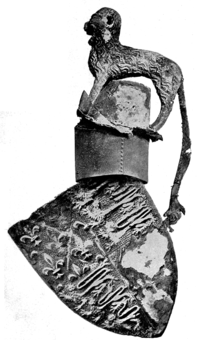
Shield, helmet and crest of Edward, the Black Prince, suspended over his tomb in Canterbury Cathedral
-
.svg.png)
Coat of arms of Philip I of Castile with the symbol representing the Leonese kingdom, along with a castle, imperially crowned in the top (Chivalric design proper of Golden Fleece Roll), Medieval Spain
Lions rampant
-
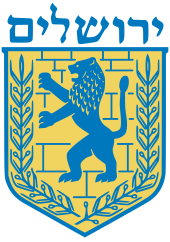
The Lion of Judah on the municipal emblem of Jerusalem
-

Coat of arms of the Kingdom of León with the Royal Crest, Medieval Spain
-

Canting coat of arms of Lyon, France
-

Barry lion in the arms of the German state of Hesse
-

Coat of Arms of Flanders
-
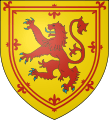
Shield from the Coat of Arms of the Kingdom of Scotland
-

Shield from the Coat of Arms of Nova Scotia, (Canada).
Many family names feature rampant lions in their crests. Examples would be: Sheals, Murphy, Morrow, Mason, Heron, Roy, MacCamley/McCamley and Hare to name but a small few.
Lions passant
-

Arms of Llywelyn (Wales)
-

Coat of Arms of the Duchy of Lancaster, (England).
Lions couchant
-

Arms of Rødøy Municipality in Norway, showing a lion couchant gules
-
.svg.png)
Arms of a municipality in Spain, showing a lion couchant proper
-

Arms of Belgorod Oblast in Russia, showing a lion couchant Or
-
.png)
Arms of the Burgdorf district in Hanover, showing a lion couchant guardant
Eastern depictions
-

Emblem of Iran, 1932–1979
-

Coat of Arms of Tajikistan, 1992-1993
-

Emblem of Tibet with a pair of snow lions
See also
| Wikimedia Commons has media related to Lions in heraldry. |
- Leo (constellation)
- Leo Belgicus
- Leo Minor
- Gallery of flags with one or more lions
- Marzocco
- The Lion and the Unicorn
Notes
- 1 2 Fox-Davies (1909), p. 172.
- ↑ Fox-Davies (1909), p. 176.
- ↑ "Segreant". Dictionary of Heraldry. 2008-08-31. Retrieved 2009-03-14.
- 1 2 Fox-Davies (1909), p. 181.
- ↑ Fox-Davies (1909), p. 182.
- 1 2 3 Fox-Davies (1909), p. 183.
- 1 2 Fox-Davies (1909), p. 184.
- 1 2 Fox-Davies (1909), p. 185.
- ↑ Fox-Davies (1909), p. 180.
- ↑ Woodcock & Robinson (1988), p. 51.
- ↑ Woodcock & Robinson (1988), p. 63.
- ↑ Woodcock & Robinson (1988), p. 64.
- ↑ Fox-Davies, Arthur Charles (1909). A Complete Guide to Heraldry. p. 173.
- ↑ Rietstap, Johannes (1884). Armorial Général. p. XXV.
- ↑ Volborth (1983), p. 27.
- ↑ Clark, Hugh; J. R. Planché (1866). An Introduction to Heraldry (18th ed.). p. 156.
- ↑ Boutell, Charles (1978) [1890]. Boutell's Heraldry. p. 79.
- ↑ Boutell, Charles (1867). English Heraldry. pp. 84–85.
- ↑ Neubecker, Ottfried (1976). Heraldry: Sources, Symbols and Meaning. Maidenhead, England: McGraw-Hill. pp. 111–2.
- ↑ Neubecker (1976), p. 112.
References
- Boutell, Charles (1867). English Heraldry. London and New York: Cassell, Petter and Galpin.
- Boutell, Charles (1978) [1890]. S. T. Aveling, ed. Boutell's Heraldry. London and New York: Frederick Warne & Co.
- Clark, Hugh; J. R. Planché (1866). An Introduction to Heraldry (18th ed.). London: Bell & Daldy.
- Fox-Davies, Arthur Charles (1909). A Complete Guide to Heraldry. London: T. C. and E. C. Jack.
- Rietstap, Johannes (1884). Armorial Général (in French). Gouda: G. B. van Goor Zonen.
| ||||||||||||||||||||||



